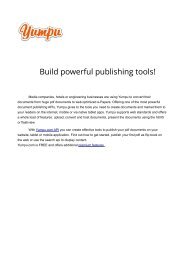test_pdf.pdf
You also want an ePaper? Increase the reach of your titles
YUMPU automatically turns print PDFs into web optimized ePapers that Google loves.
SENA<br />
ENATOR<br />
JACK<br />
REED<br />
In the fiscal year 2003 budget request, the administration proposed to begin a three-year effort design a robust<br />
nuclear earth penetrator, RNEP, to use against hard and deeply buried targets. The RNEP would modify an<br />
existing large-yield nuclear device to penetrate a hard surface, such as rock, survive, and then detonate. Senate<br />
Democrats were able to delay spending money on the RNEP for six months by requiring a report identifying the<br />
types of targets that this weapon is designed to hold at risk and the employment policy for such an RNEP. Notwithstanding<br />
the fact that there is no clear military requirement for an RNEP, the administration is forging ahead. In its<br />
fiscal year 2004 budget request, the administration proposed a second year of funding for the RNEP.<br />
Also integral to the administration’s strategy of preemption is the desire for new precision small nuclear<br />
weapons with yields of less than five kilotons. The administration’s first step towards this goal was to propose the<br />
repeal of Section 3136 of the National Defense Authorization Act for fiscal year 1994, which prohibits the secretary<br />
of Energy from conducting any research and development which could lead to the production by the United States<br />
of new low-yield nuclear weapons including a precision low-yield warhead.<br />
In 2003 <strong>test</strong>imony before the Senate Armed Services Committee, Ambassador Linton Brooks, acting director of<br />
the National Nuclear Security Administration, did not suggest that the new nuclear weapons work is needed to<br />
meet a new military requirement. Instead, he argued that, in his words, “We are seeking to free ourselves from<br />
intellectual prohibitions against exploring a full range of technical options.” Pressed further, Brooks provided a<br />
more telling explanation of the administration’s motives, saying, “I have a bias in favor of something that is the<br />
minimum destruction. That means I have a bias in favor of things that might be usable.” Despite strong Democratic<br />
opposition, the ban was repealed and $6 million was authorized for this research. Proponents of this new nuclear<br />
policy, with its bias in favor of things that are usable, argue that arms control and nonproliferation have failed and<br />
therefore new nuclear weapons, concepts, and weapons are needed. They cite a litany of states that have acquired<br />
nuclear weapons since the adoption of the [nuclear Nonproliferation Treaty] NPT in 1968: India, Israel, Pakistan,<br />
South Africa, and apparently North Korea.<br />
Arms control and nonproliferation strategies, however, succeeded in ensuring that far fewer states acquired<br />
nuclear weapons and established a global norm against the possession and use of nuclear weapons. Forty years<br />
ago, when the original nuclear powers—the United States, the Soviet Union, Britain, France, and China—had a<br />
monopoly on nuclear weapons, it was routinely assumed that proliferation would be rapid and irreversible.<br />
President Kennedy predicted in the early 1960s that an additional 25 countries might develop nuclear weapons<br />
within 10 years. This dire prediction did not come true because of efforts at arm control exemplified by the NPT.<br />
Moreover, of the five states that have acquired nuclear weapons since 1968, three—Israel, India, and Pakistan—<br />
never signed onto the NPT. South Africa gave up its nuclear weapons and joined the regime as a non-possessor<br />
state. That leaves the very special case of North Korea, which joined the NPT in 1985 and has been caught on at<br />
least two occasions violating its obligations before its announced repudiation of the treaty.<br />
Critics of the nonproliferation regime frequently fail also to acknowledge that Argentina, Brazil, South Korea,<br />
and Taiwan cease their suspected nuclear programs in part because of the international norms represented by the<br />
NPT. Similarly, with the demise of the Soviet Union, the newly independent states of Belarus, Kazakhstan, and<br />
Ukraine, found themselves in possession of nuclear weapons. All of them voluntarily relinquished their weapons<br />
in favor of joining the NPT. Their decision, at the urging of the United States and others, reaffirmed the norm of<br />
nonproliferation. At the time, Ukraine and Kazakhstan were respectively the third and fourth largest nuclear<br />
powers in the world.<br />
Despite its successes, however, the arms control regime is under stress. Today, nonproliferation is being<br />
advocated by the United States as do what I say, not do what I do. Unfortunately, the United States is more often<br />
imitated rather than obeyed. The goals of the nuclear posture review, the national security strategy, and the national<br />
strategy to combat weapons of mass destruction are reflected in congressional action authorizing new<br />
nuclear weapons research and repealing the ban on low-yield nuclear weapons research.<br />
Unfortunately, these policies and actions will begin to take the United States in a dangerous new direction<br />
that marks a major shift in American policy, which is inconsistent with our long-standing commitment under the<br />
nuclear Nonproliferation Treaty to end the nuclear arms race, and which makes a mockery of our argument to other<br />
countries around the world that they should not develop or <strong>test</strong> nuclear weapons.<br />
The Bush administration, through a series of actions taken over the past three years, is quietly moving to<br />
change the longstanding bipartisan consensus on nuclear weapons to make nuclear weapons more usable and to<br />
see them as just another option, or as a May 2003 article by Bill Keller in the New York Times Magazine suggests to<br />
make the unthinkable thinkable.<br />
The United States must reverse the course we now seem to be taking. Our nation must pursue comprehensive<br />
and practical efforts to deal with the shortcomings and unfinished parts of the global nuclear, chemical, and<br />
biological weapons arms control regime in order to adapt to the new threats and the new technologies of the post-<br />
68<br />
68
















